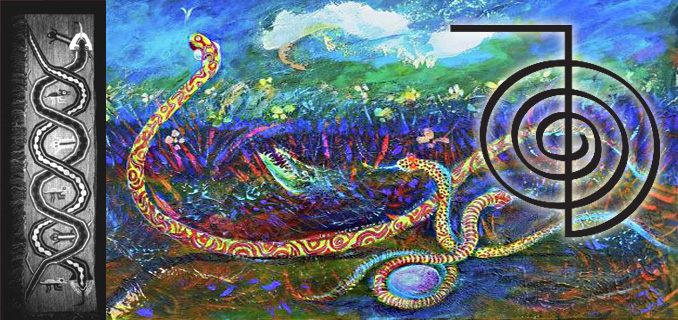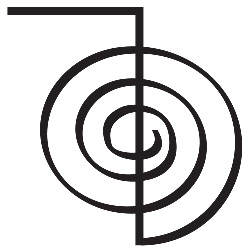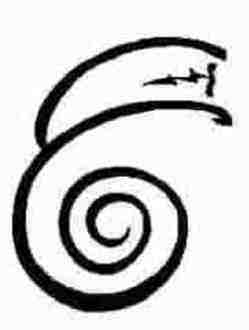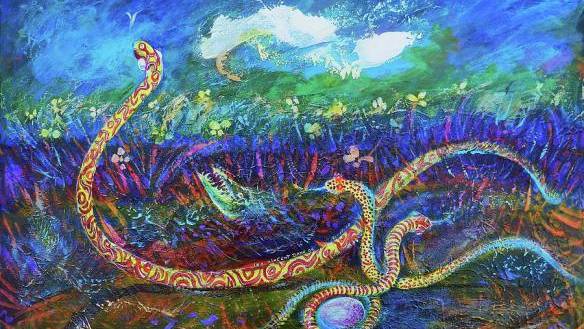The Healing of Serpents at Easter
Source: therapybook.wordpress.com

The original, pre-Christian name for Easter was Oestre, named after the goddess of the Spring Equinox, when painted eggs would be left as offerings to her in her serpent form, at her shrines. Oestre’s festival of healing and regeneration was always on the first full moon after the Spring Equinox.
The Christian church, more interested in solar iconography than lunar, adapted this date to the first Sunday after the first full moon after the Spring Equinox.
It was the Christian church that also, unfortunately, demonised the wise serpent in order to establish its own more solar religion, and in doing so, the root of cognitive framework for mind-body-spirit healing vanished from our stories which we pass down over generations, and thus from our collective consensual consciousness.
In recent years, though, there has been a resurgence in the practice of spiritual healing. This, despite more scientifically-inclined medicos insisting that it must be some kind of ‘woo woo’ which can’t really work. They think it couldn’t possibly work because the rationale for why it should work has been lost. Modern Western material science has given orthodox medicine a framework from which they cannot stray to find out what is possible, and it doesn’t recognise anything which falls outside of that purview.
So to give a rationale for spiritual healing, we need to go back before the days of Western science to find the older shamanic science which is at its root, to examine the cognitive framework upon which it was built, and that’s what this article will be about.
Thousands of years ago, our ancestors used the serpent to represent their cognitive framework upon which to base their science of holistic and spiritual healing, and it had just as much value and validity then, if not more so.
This is because early man was more shamanic in his understanding, and had realised that everything in the universe is formed from spirals and vortices of energy. When archaeologists began digging up evidence for this practice, they decided, with their modern mindset, that the ancients must have been worshipping serpents, and they referred to them as a Serpent Cults or to Ophiolatreia.
However, that Ophiolatreia was practised all over the world gives us a strong indication that its roots were planted in a universal understanding. They weren’t worshipping serpents and snakes as such… they were using the serpent as a metaphor to represent their spiritual experience and realisation about how Nature works.
Even today, it’s clear that if someone falls out of the way of Nature – either through eating the wrong foods, or breathing polluted air or drinking tainted water – then they depart from the natural balance into imbalance and they fall ill. Those who remain the healthiest and live the longest – barring accidents and disasters – are those who eat foods and drink water which is pure and natural, and which has not been contaminated by chemicals or GMOs. This is because the spiralling energies within them have not been disrupted, contorted or truncated by artificial, man-made energetic signatures.
The healing of the serpent, as its core, is about the balancing of polarities – yin and yang, hot and cold, male and female, Sun and Moon. Its aim is the culmination of what’s known in alchemy as the Divine Marriage, between the God and Goddess.
It cannot be over-emphasised that the key to spiritual healing and development is understanding that everything in Nature spirals, from universes to the contents of a single cell, and therefore to be in alignment with this spiralling energy is the only way to full health. That’s why so-called ‘magic bullet’ solutions, like chemotherapy, produce such disappointing results. A bullet flying in a straight line, delivering poison into the body (in the vain hope that it will the cancer before it kills the patient) fails on just about every level.
This life-giving, spiralling, serpent energy is used by shamans and any other healers who work with spirit guides, such as Reiki healers. Often, the healer may not realise that they are working with spiralling energies, but they don’t have to, so long as they are aligning with their spirit guides. The spirit guides know exactly what energies to access and how to use the human healer as a conduit for these serpentine flows. It’s no coincidence, though, that two of the Reiki power symbols (the Chokurei and the Dai Ko Mio) are based on the spiral form.
Chokurei

Dai Ko Mio

In his book The Cosmic Serpent, biologist Jeremy Narby tells us about the shamans in the jungles of the Amazon who heal through contacting the spirit of the DNA. In the cognitive framework of this natural science, the DNA is seen in ayahuasca visions as twinned serpents. These shamans told him that once the serpent in the DNA has been found, the karmic residue contained in the ancestral memory can be released, enabling the receiver to align themselves with their life’s Destiny.
In this work with water, the Austrian naturalist and inventor Viktor Schauberger found that inwardly spiralling water contains the most oxygen and live-giving properties, and that water left its own devices will naturally meander through channels which create this vertical effect. It’s only when water is forced through straight, man-made canals that it loses its vibrancy. “Observe and copy Nature” was Viktor Schauberger’s motto.
With this understanding about water vortices, we can also now understand the importance of both the Moon to the ancients – because the Moon has its own relationship with water and pulls on it to create tidal cycles.
Dowsers and other sensitives tell us that the Moon also has an impact on serpent lines or dragon lines in the Earth, otherwise known as leylines. Apparently, the serpent lines are at their widest and most potent during a full moon, and that they wane and wax in size in alignment with the lunar cycle.
So with this understanding, we can perhaps begin to understand where the tradition of egg-giving at Easter comes from. Our ancestors would make an offering of eggs to the serpent goddess Oestre on the first full moon after the Spring Equinox, at shrines which were on the nodes (crossing points) of leylines in full flow.
To explain why eggs are offered to the serpent, I will be shamelessly plundering an excellent essay by Hermetic artist Harry Wendrich for the newsletter of the Network of Leyhunters. He explains several of the symbols that archaeologists have unearthed in connection with the so-called Serpent Cults.
The Tree and the Serpent
The tree is locked into the Earth. Its trunk is phallic, its branches represent many serpents from the one. The leaves represent the magnetic frequency we call archetypes, which need to be balanced before the serpent rises….
[...]
Read the full article at: therapybook.wordpress.com
READ: The Babylonian Origins of Easter (Ishtar)
Tune into Red Ice Radio:
Jeremy Narby - The Cosmic Serpent, DNA, Knowledge & Intelligence in Nature
Hugh Montgomery - The God-Kings: Babylon, Ulvungar, Oden & Jesus
David Icke - 2012, The Reptilian & The Peru Experience
Craig Hines - Gateway of the Gods
Pierre Sabak - Hidden Symbolism of the Dragon
Edmund Marriage - Kharsag, Garden of Eden & Earth, Sun, Global Cooling






















